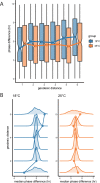This is a preprint.
Temperature-driven coordination of circadian transcriptome regulation
- PMID: 37961403
- PMCID: PMC10634908
- DOI: 10.1101/2023.10.27.563979
Temperature-driven coordination of circadian transcriptome regulation
Update in
-
Temperature-driven coordination of circadian transcriptional regulation.PLoS Comput Biol. 2024 Apr 22;20(4):e1012029. doi: 10.1371/journal.pcbi.1012029. eCollection 2024 Apr. PLoS Comput Biol. 2024. PMID: 38648221 Free PMC article.
Abstract
The circadian rhythm is an evolutionarily-conserved molecular oscillator that enables species to anticipate rhythmic changes in their environment. At a molecular level, the core clock genes induce a circadian oscillation in thousands of genes in a tissue-specific manner, orchestrating myriad biological processes. While studies have investigated how the core clock circuit responds to environmental perturbations such as temperature, the downstream effects of such perturbations on circadian regulation remain poorly understood. By analyzing bulk-RNA sequencing of Drosophila fat bodies harvested from flies subjected to different environmental conditions, we demonstrate a highly condition-specific circadian transcriptome. Further employing a reference-based gene regulatory network (Reactome), we find evidence of increased gene-gene coordination at low temperatures and synchronization of rhythmic genes that are network neighbors. Our results point to the mechanisms by which the circadian clock mediates the fly's response to seasonal changes in temperature.
Keywords: Circadian rhythms; Drosophila melanogaster; Gene regulatory networks; Seasonal adaptation; Temperature perturbation.
Figures




References
-
- Lim Chunghun and Allada Ravi. Emerging roles for post-transcriptional regulation in circadian clocks. Nature Neuroscience, 16(11):1544–1550, 2013. - PubMed
-
- Liu Yi, Merrow Martha, Loros Jennifer J., and Dunlap Jay C. How Temperature Changes Reset a Circadian Oscillator. Science, 281(5378):825–829, August 1998. - PubMed
Publication types
Grants and funding
LinkOut - more resources
Full Text Sources
Molecular Biology Databases
